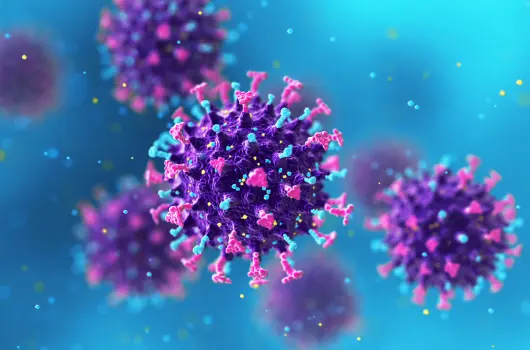Clinical Study
Gastrointestinal Pathogen Positivity Trend Report

Allie Priego, PA-C • July 25, 2025
Acute diarrheal illness is a leading cause of outpatient visits, emergency department encounters, and missed work and school in the United States. It is estimated that Americans experience about 179 million episodes of acute gastroenteritis annually, leading to over 1.5 million outpatient visits and around 200,000 hospitalizations each year.1 While most cases are self-limited, certain pathogens—especially in young children, older adults, and immunocompromised individuals—can cause significant morbidity.
As we analyze gastrointestinal pathogen data from the last six months of 2024 compared to 2025 so far, some interesting trends emerge. Below we highlight the positivity rates of several key pathogens, along with clinical context to help interpret these findings.
- Norovirus
- Jan – July 2025: 7.2% (increase)
- July – Dec 2024: 6.5%
- Norovirus remains the leading cause of acute viral gastroenteritis across all age groups. Its highly contagious nature and resilience on surfaces make it a frequent culprit in outbreaks, particularly in closed settings like schools and nursing homes.2 Although we are only halfway through 2025, Norovirus is already at a higher positivity rate than the latter half of 2024.
- Cryptosporidium
- Jan – July 2025: 1.0% (decrease)
- July – Dec 2024: 1.6%
- Cryptosporidium, a protozoan parasite, causes watery diarrhea and is notable for its resistance to chlorine, making it a persistent threat in swimming pools and water supplies.3 The drop in positivity could reflect improved water treatment, hygiene awareness, or simply lower transmission this year.
- ErmB, C; mefA resistance gene (resistance to Macrolides, Lincosamide, and Streptogramin antibiotics)
- Jan – July 2025: 17.3% (decrease)
- July – Dec 2024: 24.1%
- These resistance genes — which confer resistance to Macrolides, Lincosamide, and Streptogramin antibiotics — were detected less frequently in the first half of 2025. This may indicate shifts in bacterial populations or prescribing practices. However, the rates remain significant, underscoring the importance of antimicrobial stewardship.4,5
- Salmonella
- Jan – July 2025: 1.5% (decrease)
- July – Dec 2024: 3.0%
- Salmonella, commonly associated with undercooked poultry, eggs, and produce, showed a notable decline in 2025. This could reflect improved food safety practices or reduced exposure during certain seasons. Nevertheless, it remains an important bacterial cause of gastroenteritis and warrants continued vigilance as remains one of the leading causes of foodborne diarrheal disease globally, with an estimated 150 million cases and 60,000 deaths annually.6
- Rotavirus
- Jan – July 2025: 2.9% (increase)
- July – Dec 2024: 0.7%
- Rotavirus infections increased significantly in the first half of 2025 compared to the latter half of 2024. One possible contributor could be declining vaccination rates, which have been observed in some areas in recent years. Rotavirus primarily affects infants and young children and can lead to severe dehydration, making vaccination a key preventive measure.7
These findings highlight how gastrointestinal pathogen positivity rates can shift from year to year, influenced by factors such as seasonality, vaccination uptake, hygiene practices, diagnostic testing patterns, and antimicrobial resistance trends. Understanding these patterns helps clinicians recognize emerging threats, guide appropriate testing and treatment, and reinforce prevention strategies like vaccination, food safety, and antimicrobial stewardship. Ongoing surveillance remains crucial to reducing the burden of diarrheal disease and protecting vulnerable populations.
References
- Moon, R. C., Bleak, T. C., Rosenthal, N. A., Couturier, B., Hemmert, R., Timbrook, T. T., Brown, H., & Fang, F. C. (2023). Epidemiology and Economic Burden of Acute Infectious Gastroenteritis Among Adults Treated in Outpatient Settings in US Health Systems. The American Journal of Gastroenterology, 118(6), 1069–1079.
https://doi.org/10.14309/ajg.0000000000002186 - Division of Viral Diseases, National Center for Immunization and Respiratory Diseases, Centers for Disease Control and Prevention (2011). Updated norovirus outbreak management and disease prevention guidelines. MMWR. Recommendations and Reports, 60(RR-3), 1–18.
- Leav, B. A., Mackay, M., & Ward, H. D. (2003). Cryptosporidium species: new insights and old challenges. Clinical Infectious Diseases, 36(7), 903–908.
https://doi.org/10.1086/368194 - Wang, Y., Zhang, M., Deng, F., Shen, Z., Wu, C., Zhang, J., Zhang, Q., & Shen, J. (2014). Emergence of multidrug-resistant Campylobacter species isolates with a horizontally acquired rRNA methylase. Antimicrobial Agents and Chemotherapy, 58(9), 5405–5412.
https://doi.org/10.1128/AAC.03039-14
- Taitt, C. R., Leski, T. A., Prouty, M. G., Ford, G. W., Heang, V., House, B. L., Levin, S. Y., Curry, J. A., Mansour, A., Mohammady, H. E., Wasfy, M., Tilley, D. H., Gregory, M. J., Kasper, M. R., Regeimbal, J., Rios, P., Pimentel, G., Danboise, B. A., Hulseberg, C. E., Odundo, E. A., … Vora, G. J. (2020). Tracking Antimicrobial Resistance Determinants in Diarrheal Pathogens: A Cross-Institutional Pilot Study. International Journal of Molecular Sciences, 21(16), 5928.
https://doi.org/10.3390/ijms21165928 - Centers for Disease Control and Prevention. (n.d.-a). Post-travel diarrhea. Centers for Disease Control and Prevention.
https://www.cdc.gov/yellow-book/hcp/post-travel-evaluation/post-travel-diarrhea.html - Operario, D. J., Platts-Mills, J. A., Nadan, S., Page, N., Seheri, M., Mphahlele, J., Praharaj, I., Kang, G., Araujo, I. T., Leite, J. P. G., Cowley, D., Thomas, S., Kirkwood, C. D., Dennis, F., Armah, G., Mwenda, J. M., Wijesinghe, P. R., Rey, G., Grabovac, V., Berejena, C., … Houpt, E. R. (2017). Etiology of Severe Acute Watery Diarrhea in Children in the Global Rotavirus Surveillance Network Using Quantitative Polymerase Chain Reaction. The Journal of Infectious Diseases, 216(2), 220–227.
https://doi.org/10.1093/infdis/jix294
References
- Moon, R. C., Bleak, T. C., Rosenthal, N. A., Couturier, B., Hemmert, R., Timbrook, T. T., Brown, H., & Fang, F. C. (2023). Epidemiology and Economic Burden of Acute Infectious Gastroenteritis Among Adults Treated in Outpatient Settings in US Health Systems. The American Journal of Gastroenterology, 118(6), 1069–1079.
https://doi.org/10.14309/ajg.0000000000002186 - Division of Viral Diseases, National Center for Immunization and Respiratory Diseases, Centers for Disease Control and Prevention (2011). Updated norovirus outbreak management and disease prevention guidelines. MMWR. Recommendations and Reports, 60(RR-3), 1–18.
- Leav, B. A., Mackay, M., & Ward, H. D. (2003). Cryptosporidium species: new insights and old challenges. Clinical Infectious Diseases, 36(7), 903–908.
https://doi.org/10.1086/368194 - Wang, Y., Zhang, M., Deng, F., Shen, Z., Wu, C., Zhang, J., Zhang, Q., & Shen, J. (2014). Emergence of multidrug-resistant Campylobacter species isolates with a horizontally acquired rRNA methylase. Antimicrobial Agents and Chemotherapy, 58(9), 5405–5412.
https://doi.org/10.1128/AAC.03039-14 - Taitt, C. R., Leski, T. A., Prouty, M. G., Ford, G. W., Heang, V., House, B. L., Levin, S. Y., Curry, J. A., Mansour, A., Mohammady, H. E., Wasfy, M., Tilley, D. H., Gregory, M. J., Kasper, M. R., Regeimbal, J., Rios, P., Pimentel, G., Danboise, B. A., Hulseberg, C. E., Odundo, E. A., … Vora, G. J. (2020). Tracking Antimicrobial Resistance Determinants in Diarrheal Pathogens: A Cross-Institutional Pilot Study. International Journal of Molecular Sciences, 21(16), 5928.
https://doi.org/10.3390/ijms21165928 - Centers for Disease Control and Prevention. (n.d.-a). Post-travel diarrhea. Centers for Disease Control and Prevention.
https://www.cdc.gov/yellow-book/hcp/post-travel-evaluation/post-travel-diarrhea.html - Operario, D. J., Platts-Mills, J. A., Nadan, S., Page, N., Seheri, M., Mphahlele, J., Praharaj, I., Kang, G., Araujo, I. T., Leite, J. P. G., Cowley, D., Thomas, S., Kirkwood, C. D., Dennis, F., Armah, G., Mwenda, J. M., Wijesinghe, P. R., Rey, G., Grabovac, V., Berejena, C., … Houpt, E. R. (2017). Etiology of Severe Acute Watery Diarrhea in Children in the Global Rotavirus Surveillance Network Using Quantitative Polymerase Chain Reaction. The Journal of Infectious Diseases, 216(2), 220–227.
https://doi.org/10.1093/infdis/jix294
Related Articles and White papers

Allie Priego, PA-C • July 25, 2025
Acute diarrheal illness is a leading cause of outpatient visits, emergency department encounters, and missed work and school in the United States. It is estimated that Americans experience about 179 million episodes of acute gastroenteritis annually, leading to over 1.5 million outpatient visits and around 200,000 hospitalizations each year.1 While most cases are self-limited, certain pathogens—especially in young children, older adults, and immunocompromised individuals—can cause significant morbidity.
As we analyze gastrointestinal pathogen data from the last six months of 2024 compared to 2025 so far, some interesting trends emerge. Below we highlight the positivity rates of several key pathogens, along with clinical context to help interpret these findings.
- Norovirus
- Jan – July 2025: 7.2% (increase)
- July – Dec 2024: 6.5%
- Norovirus remains the leading cause of acute viral gastroenteritis across all age groups. Its highly contagious nature and resilience on surfaces make it a frequent culprit in outbreaks, particularly in closed settings like schools and nursing homes.2 Although we are only halfway through 2025, Norovirus is already at a higher positivity rate than the latter half of 2024.
- Cryptosporidium
- Jan – July 2025: 1.0% (decrease)
- July – Dec 2024: 1.6%
- Cryptosporidium, a protozoan parasite, causes watery diarrhea and is notable for its resistance to chlorine, making it a persistent threat in swimming pools and water supplies.3 The drop in positivity could reflect improved water treatment, hygiene awareness, or simply lower transmission this year.
- ErmB, C; mefA resistance gene (resistance to Macrolides, Lincosamide, and Streptogramin antibiotics)
- Jan – July 2025: 17.3% (decrease)
- July – Dec 2024: 24.1%
- These resistance genes — which confer resistance to Macrolides, Lincosamide, and Streptogramin antibiotics — were detected less frequently in the first half of 2025. This may indicate shifts in bacterial populations or prescribing practices. However, the rates remain significant, underscoring the importance of antimicrobial stewardship.4,5
- Salmonella
- Jan – July 2025: 1.5% (decrease)
- July – Dec 2024: 3.0%
- Salmonella, commonly associated with undercooked poultry, eggs, and produce, showed a notable decline in 2025. This could reflect improved food safety practices or reduced exposure during certain seasons. Nevertheless, it remains an important bacterial cause of gastroenteritis and warrants continued vigilance as remains one of the leading causes of foodborne diarrheal disease globally, with an estimated 150 million cases and 60,000 deaths annually.6
- Rotavirus
- Jan – July 2025: 2.9% (increase)
- July – Dec 2024: 0.7%
- Rotavirus infections increased significantly in the first half of 2025 compared to the latter half of 2024. One possible contributor could be declining vaccination rates, which have been observed in some areas in recent years. Rotavirus primarily affects infants and young children and can lead to severe dehydration, making vaccination a key preventive measure.7
These findings highlight how gastrointestinal pathogen positivity rates can shift from year to year, influenced by factors such as seasonality, vaccination uptake, hygiene practices, diagnostic testing patterns, and antimicrobial resistance trends. Understanding these patterns helps clinicians recognize emerging threats, guide appropriate testing and treatment, and reinforce prevention strategies like vaccination, food safety, and antimicrobial stewardship. Ongoing surveillance remains crucial to reducing the burden of diarrheal disease and protecting vulnerable populations.
References
- Moon, R. C., Bleak, T. C., Rosenthal, N. A., Couturier, B., Hemmert, R., Timbrook, T. T., Brown, H., & Fang, F. C. (2023). Epidemiology and Economic Burden of Acute Infectious Gastroenteritis Among Adults Treated in Outpatient Settings in US Health Systems. The American Journal of Gastroenterology, 118(6), 1069–1079.
https://doi.org/10.14309/ajg.0000000000002186 - Division of Viral Diseases, National Center for Immunization and Respiratory Diseases, Centers for Disease Control and Prevention (2011). Updated norovirus outbreak management and disease prevention guidelines. MMWR. Recommendations and Reports, 60(RR-3), 1–18.
- Leav, B. A., Mackay, M., & Ward, H. D. (2003). Cryptosporidium species: new insights and old challenges. Clinical Infectious Diseases, 36(7), 903–908.
https://doi.org/10.1086/368194 - Wang, Y., Zhang, M., Deng, F., Shen, Z., Wu, C., Zhang, J., Zhang, Q., & Shen, J. (2014). Emergence of multidrug-resistant Campylobacter species isolates with a horizontally acquired rRNA methylase. Antimicrobial Agents and Chemotherapy, 58(9), 5405–5412.
https://doi.org/10.1128/AAC.03039-14
- Taitt, C. R., Leski, T. A., Prouty, M. G., Ford, G. W., Heang, V., House, B. L., Levin, S. Y., Curry, J. A., Mansour, A., Mohammady, H. E., Wasfy, M., Tilley, D. H., Gregory, M. J., Kasper, M. R., Regeimbal, J., Rios, P., Pimentel, G., Danboise, B. A., Hulseberg, C. E., Odundo, E. A., … Vora, G. J. (2020). Tracking Antimicrobial Resistance Determinants in Diarrheal Pathogens: A Cross-Institutional Pilot Study. International Journal of Molecular Sciences, 21(16), 5928.
https://doi.org/10.3390/ijms21165928 - Centers for Disease Control and Prevention. (n.d.-a). Post-travel diarrhea. Centers for Disease Control and Prevention.
https://www.cdc.gov/yellow-book/hcp/post-travel-evaluation/post-travel-diarrhea.html - Operario, D. J., Platts-Mills, J. A., Nadan, S., Page, N., Seheri, M., Mphahlele, J., Praharaj, I., Kang, G., Araujo, I. T., Leite, J. P. G., Cowley, D., Thomas, S., Kirkwood, C. D., Dennis, F., Armah, G., Mwenda, J. M., Wijesinghe, P. R., Rey, G., Grabovac, V., Berejena, C., … Houpt, E. R. (2017). Etiology of Severe Acute Watery Diarrhea in Children in the Global Rotavirus Surveillance Network Using Quantitative Polymerase Chain Reaction. The Journal of Infectious Diseases, 216(2), 220–227.
https://doi.org/10.1093/infdis/jix294
References
- Moon, R. C., Bleak, T. C., Rosenthal, N. A., Couturier, B., Hemmert, R., Timbrook, T. T., Brown, H., & Fang, F. C. (2023). Epidemiology and Economic Burden of Acute Infectious Gastroenteritis Among Adults Treated in Outpatient Settings in US Health Systems. The American Journal of Gastroenterology, 118(6), 1069–1079.
https://doi.org/10.14309/ajg.0000000000002186 - Division of Viral Diseases, National Center for Immunization and Respiratory Diseases, Centers for Disease Control and Prevention (2011). Updated norovirus outbreak management and disease prevention guidelines. MMWR. Recommendations and Reports, 60(RR-3), 1–18.
- Leav, B. A., Mackay, M., & Ward, H. D. (2003). Cryptosporidium species: new insights and old challenges. Clinical Infectious Diseases, 36(7), 903–908.
https://doi.org/10.1086/368194 - Wang, Y., Zhang, M., Deng, F., Shen, Z., Wu, C., Zhang, J., Zhang, Q., & Shen, J. (2014). Emergence of multidrug-resistant Campylobacter species isolates with a horizontally acquired rRNA methylase. Antimicrobial Agents and Chemotherapy, 58(9), 5405–5412.
https://doi.org/10.1128/AAC.03039-14 - Taitt, C. R., Leski, T. A., Prouty, M. G., Ford, G. W., Heang, V., House, B. L., Levin, S. Y., Curry, J. A., Mansour, A., Mohammady, H. E., Wasfy, M., Tilley, D. H., Gregory, M. J., Kasper, M. R., Regeimbal, J., Rios, P., Pimentel, G., Danboise, B. A., Hulseberg, C. E., Odundo, E. A., … Vora, G. J. (2020). Tracking Antimicrobial Resistance Determinants in Diarrheal Pathogens: A Cross-Institutional Pilot Study. International Journal of Molecular Sciences, 21(16), 5928.
https://doi.org/10.3390/ijms21165928 - Centers for Disease Control and Prevention. (n.d.-a). Post-travel diarrhea. Centers for Disease Control and Prevention.
https://www.cdc.gov/yellow-book/hcp/post-travel-evaluation/post-travel-diarrhea.html - Operario, D. J., Platts-Mills, J. A., Nadan, S., Page, N., Seheri, M., Mphahlele, J., Praharaj, I., Kang, G., Araujo, I. T., Leite, J. P. G., Cowley, D., Thomas, S., Kirkwood, C. D., Dennis, F., Armah, G., Mwenda, J. M., Wijesinghe, P. R., Rey, G., Grabovac, V., Berejena, C., … Houpt, E. R. (2017). Etiology of Severe Acute Watery Diarrhea in Children in the Global Rotavirus Surveillance Network Using Quantitative Polymerase Chain Reaction. The Journal of Infectious Diseases, 216(2), 220–227.
https://doi.org/10.1093/infdis/jix294





